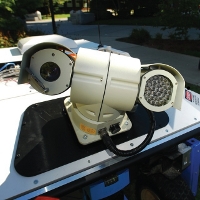Competition Info
Competition Rules
Objective:
The theme of the competition is to develop an innovative and creative solution that uses Robot Mobility through Unconventional Means.
General Rules:
Team Rules- Each team must consist of a minimum of 3 members. Team members must be enrolled students at either the graduate or undergraduate level at the time of registration. Full-time and part-time students are eligible to compete.
- Teams must have at least one advisor, but may have an unlimited number of additional advisors.
- Teams must apply during the application window (listed below). Teams will be notified if their application is accepted or declined within 10 days of receiving the application via a letter sent by the competition administrator.
- All teams must submit a detailed description of project entry by the due date below following the form posted on the competition website.
- Teams will be designated to compete in the Undergraduate or Graduate Team Division based on the student status of team members. Teams with that least one full-time or part-time graduate student will be considered a Graduate Team.
- A robot is defined as an electro-mechanical-computing system that senses and interacts with its environment.
- The robot or technologies and methods of the robot must exhibit mobility through unconventional means.
- The innovation presented must have been developed in the past 12 months or significant, measurable improvements made by the team in the past 12 months. Judges may make exception for work outside that scope that has never been previously published or presented.
- Teams must have a functional prototype robot to demonstrate at the competition.
- It is recommended that the robot fit in a 1 m wide x 1 m deep x 2 m tall envelope given the presentation venue. Those who anticipate their robot will exceed this envelope must contact the competition administrator for approval.
- Since any robots utilizing flammable or combustible fuels will be accommodated outdoors, contact the competition administrator for approval if you intend to use such them in your prototype.
- All robots must be designed to avoid injury or posing a hazard to people or the demonstration environment.
- All pinch hazards, chains, belts, gears, and rotating shafts must be fully shielded or otherwise designed to avoid injury from accidental contact.
- All systems must be designed to avoid shock hazard. No electrical contacts may be exposed, except for sensors requiring exposure. If sensors are to be used in contact with the human body, they must satisfy all applicable regulations.
- Every electrical circuit must have appropriate over current protection
- Any electrical component must be used within the manufacturers operating rating.
- Any hazardous, corrosive, or flammable liquids, solids, or gases must have auxiliary containment to prevent chemical spills
- Any energy storage device must be shielded or contained in such a way that a failure of any component of the robot will not pose a danger.
- Shielding or other design methods must be in place to mitigate ejection hazards.
- In the event of a failure, the robot must be fail-safe.
Awards:
- Cash prizes up to $5,000 will be awarded.
- Trophies for first place and individual categories in both the Undergraduate and Graduate Team divisions.
- An opportunity to present at the TEPRA Conference for the overall top submission from all divisions, as decided by the judges.
Click here for the complete RICC rules and judging criteria.
Competition Dates of Interest
| Competition Guidelines Posted | September 8, 2010 |
| Application Due | November 8, 2010 - March 4, 2011 |
| Detailed Description of Project Entry Due | March 4, 2011 |
| Participation Confirmation | March 11, 2011 |
| Written Report Due | March 25, 2011 |
| Competition | April 10, 2011 |



